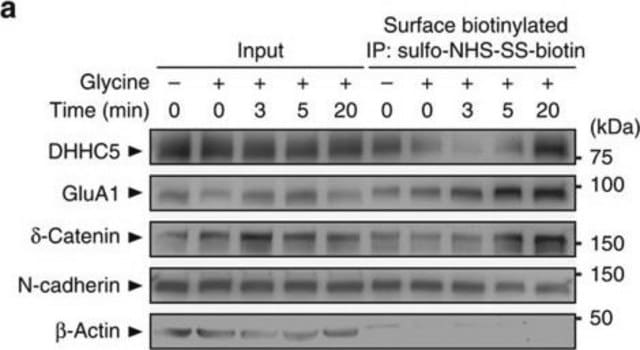MABN1573
Anti-Synapsin-2 Antibody, clone 19.4
clone 19.4, from mouse
Sinônimo(s):
Synapsin II, Synapsin-2
About This Item
Produtos recomendados
fonte biológica
mouse
Nível de qualidade
forma do anticorpo
purified immunoglobulin
tipo de produto de anticorpo
primary antibodies
clone
19.4, monoclonal
reatividade de espécies
rat, mouse, human
técnica(s)
activity assay: suitable
immunohistochemistry: suitable (paraffin)
immunoprecipitation (IP): suitable
western blot: suitable
Isotipo
IgG2aκ
nº de adesão NCBI
nº de adesão UniProt
Condições de expedição
dry ice
modificação pós-traducional do alvo
unmodified
Informações sobre genes
human ... SYN2(6854)
Descrição geral
Especificidade
Imunogênio
Aplicação
Western Blotting Analysis: Target detection by a representative lot was blocked by a preincubation with phage particles displaying peptides containing the SYIxN consensus sequence (Vaccaro, P., et al. (1997). Brain Res. Mol. Brain Res. 52(1):1-16).
Western Blotting Analysis: A representative lot detected synapsin IIa/IIb, but not Ia/Ib, in rat brain cytosolic extracts (Vaccaro, P., et al. (1997). Brain Res. Mol. Brain Res. 52(1):1-16).
Immunoprecipitation Analysis: A representative lot immunoprecipitated synapsin IIa/IIb, but not Ia/Ib, from rat brain synaptosomal preparations (Vaccaro, P., et al. (1997). Brain Res. Mol. Brain Res. 52(1):1-16).
Enzyme Assay Analysis: A representative lot, when added 2 hours prior to cAMP, prevented PKA-catalyzed phosphorylation of synapsin IIa/IIb in an in vitro kinase assay using rat brain synaptosomal preparations (Vaccaro, P., et al. (1997). Brain Res. Mol. Brain Res. 52(1):1-16).
Neuroscience
Developmental Neuroscience
Qualidade
Western Blotting Analysis: 0.5 µg/mL of this antibody detected Synapsin-2 in 10 µg of rat brain tissue lysate.
Descrição-alvo
forma física
Armazenamento e estabilidade
Handling Recommendations: Upon receipt and prior to removing the cap, centrifuge the vial and gently mix the solution. Aliquot into microcentrifuge tubes and store at -20°C. Avoid repeated freeze/thaw cycles, which may damage IgG and affect product performance.
Outras notas
Exoneração de responsabilidade
Não está encontrando o produto certo?
Experimente o nosso Ferramenta de seleção de produtos.
Código de classe de armazenamento
12 - Non Combustible Liquids
Classe de risco de água (WGK)
WGK 2
Ponto de fulgor (°F)
Not applicable
Ponto de fulgor (°C)
Not applicable
Certificados de análise (COA)
Busque Certificados de análise (COA) digitando o Número do Lote do produto. Os números de lote e remessa podem ser encontrados no rótulo de um produto após a palavra “Lot” ou “Batch”.
Já possui este produto?
Encontre a documentação dos produtos que você adquiriu recentemente na biblioteca de documentos.
Nossa equipe de cientistas tem experiência em todas as áreas de pesquisa, incluindo Life Sciences, ciência de materiais, síntese química, cromatografia, química analítica e muitas outras.
Entre em contato com a assistência técnica








